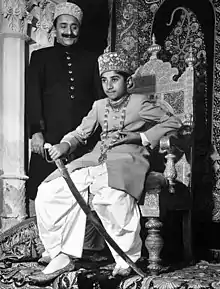George Ali Murad Khan
Ali Murad Khan II Talpur (born 29 June 1933) was the Mir (ruler) of Khairpur from 1947 to 1954. At an age of nine months, Khan was mistakenly shot by his father. Although the bullet passed through his right lung and stomach, he survived. Ascending to the throne after his father's removal from power, he chose to accede to the Dominion of Pakistan in the same year and was invested with full powers by Liaquat Ali Khan in 1951. Three years later, the state merged with Pakistan, removing Khan's sovereign status. Khan fathered two sons, Abbas Raza Khan and Mehdi Raza Khan and one daughter Zahra from his second wife.
| Ali Murad Khan | |
|---|---|
| Mir | |
 George Ali Murad Khan sitting on throne, July 1947 | |
| Mir of Khairpur | |
| Reign | 24 July 1947 – 10 November 1954 |
| Coronation | Faiz Mahal |
| Predecessor | Faiz Muhammad Khan II |
| Successor | Monarchy abolished |
| Born | George Ali Murad Khan 29 June 1933 Brighton, Sussex, United Kingdom |
| Begum | Saddiquah Begum Alya Talpur |
| Issue | 3 |
| House | Talpur |
| Father | Faiz Muhammad Khan II |
| Mother | Dulhan Pasha Begum |
| Religion | Islam |
Early life
Khan was born on 29 June 1933 at Brighton, Sussex in United Kingdom to Mir Faiz Muhammad Khan II and Dulhan Pasha Begum. He studied at St Bonaventure's High School in Hyderabad followed by Aitchison College, Lahore, before graduating from the University of Cambridge.[1]
At an age of nine months, Khan was mistakenly shot by his father. Although the bullet passed through his right lung and stomach, he survived.[1]
Reign
Khan's father Faiz Muhammad Khan II was deposed by the British on 19 July 1947,[1] due to being declared mentally unfit.[2] On 24 July, he ascended the throne at Faiz Mahal[1] but a regency board, consisting of his close relatives was created to govern the state on his behalf, as he was a minor.[3]
During Khan's reign, Khairpur spanned over 15,700 square kilometres (6,050 sq mi) with a population of around 300,000[3] and a substantial part of the Lahore-Karachi railway track was within the state, thus making it a high-value territory for the newly formed Pakistan.[3] On 4 August 1947, the state government issued a notification declaring that 15 August would be celebrated as the state's independence day[3] and finally after rounds of negotiation,[4] on 3 October, Mir Ghulam Hussain Khan—one of the regents, signed the instrument of accession on behalf of Khan acceding the state to the Dominion of Pakistan.[3]
A supplementary instrument signed on 1 February 1949 considerably reduced the effective powers of Khan and the Durbar and not only took control of the armed forces but also bound the chief-minister to be appointed only after consultation with the national government. [5] The Government of Khairpur Act, 1949 was subsequently passed which initiated for quasi-democratic reforms and established a 15-member legislative assembly composed of local representatives.[6] It thus became one of the two states (the other one being Bahwalpur) of Pakistan, where universal adult franchise was enabled for the first time.[7] But, democratic ideals failed to develop,[7] given that the proceedings of the assembly were allowed to be veto-able by the Chief-minister and additionally, the Chief Minister was granted absolute authority to promulgate laws without the consent of the assembly.[6] In 1951, Prime Minister Liaquat Ali Khan investitured an 18 year old Khan with absolute ruling powers and disbanded the regents-council.[1][8] The Government of Khairpur Act was soon passed in 1953 despite strong reservations of Khan, converting Khairpur into a province and consolidating further powers in the hands of centrally appointed chief-minister.[8] On 25 May 1954, the assembly passed a resolution that rejected proposals of being merged with Sindh.[9] Finally, on 10 November 1954, the state assembly was somewhat compelled to pass a resolution to absolutely merge with the Dominion of Pakistan and remove Khan's claim to any minimal extent of sovereignty.[9]
Personal life
Khan's first wife was Ghulam Saddiquah Begum, the daughter of Nawab Sadeq Mohammad Khan V of Bahawalpur State, whom he married at the Sadiqgarh Palace in Bahawalpur.[1] His second wife was Alya Talpur, a daughter of religious scholar Rasheed Turabi. She died on 8 February 2019.[10] Khan fathered two sons, Abbas Raza Khan and Mehdi Raza Khan and one daughter Zahra from his second wife.[1]
Bibliography
Notes
- "The boy prince (1947)". Friday Times. 3 March 2017. Archived from the original on 3 March 2017.
- "Subjects to citizens". The Friday Times. 7 August 2015. Archived from the original on 26 April 2019. Retrieved 26 April 2019.
- "The Dawn of Pakistan". Dawn. Archived from the original on 12 April 2019. Retrieved 12 April 2019.
- Wilcox 1963
- Long et al. 2015, p. 84
- Long et al. 2015, p. 90
- Long et al. 2015, p. 93
- Long et al. 2015, p. 86
- Long et al. 2015, pp. 94–95
- Ali, Imtiaz (8 February 2019). "Khairpur's 'last princess' passes away in Karachi". Dawn. Archived from the original on 12 April 2019. Retrieved 12 April 2019.
References
- Long, Roger D.; Singh, Gurharpal; Samad, Yunas; Talbot, Ian (2015). State and Nation-Building in Pakistan: Beyond Islam and Security. Routledge. ISBN 9781317448204.CS1 maint: ref=harv (link)
- Wilcox, Wayne Ayres (1963). Pakistan. The Consolidation of a Nation. Columbia University Press. ISBN 9780231887700. OCLC 504316667.CS1 maint: ref=harv (link)